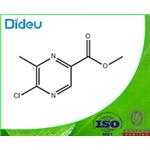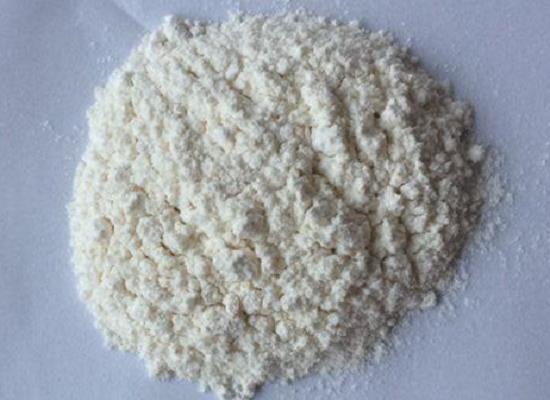Methyl 5-chloro-6-methylpyrazine-2-carboxylate: properties, synthesis and safety
Dec 14,2023
General Description
Methyl 5-chloro-6-methylpyrazine-2-carboxylate is a chemical compound with potential applications in pharmaceutical and chemical research. It exhibits moderate hydrophobicity and the ability to interact with polar substances. The compound can inhibit the STING pathway, making it a promising immunomodulator for diseases like cancer. Formulating it into pharmaceutical compositions allows for convenient administration. Safety precautions should be taken when handling this compound, including proper ventilation, personal protective equipment, and following safety procedures outlined in the Material Safety Data Sheet (MSDS) or provided by the manufacturer. Further research is needed to explore its full therapeutic potential and optimize its formulation for clinical use.

Figure 1. Methyl 5-chloro-6-methylpyrazine-2-carboxylate
Properties
Methyl 5-chloro-6-methylpyrazine-2-carboxylate is a chemical compound with the molecular formula C7H7ClN2O2 and a molecular weight of 186.59 g/mol. It possesses several notable physical and chemical properties. With an XLogP3-AA value of 1.3, it suggests moderate hydrophobicity. The compound has a topological polar surface area of 52.1 Ų, indicating its ability to interact with polar substances. It contains four hydrogen bond acceptors, enabling potential interactions with other molecules. The presence of two rotatable bonds suggests its flexibility in terms of conformational changes. Methyl 5-chloro-6-methylpyrazine-2-carboxylate has a complexity of 177, indicating its structural intricacy. It consists of a single covalently-bonded unit. Its exact and monoisotopic mass is 186.0196052 g/mol, providing precise information about its atomic composition. Due to its interesting properties, this compound has attracted attention in pharmaceutical and chemical research. Notably, researchers have explored its potential as an inhibitor of monoacylglycerol lipase (MAGL) based on related patents and its availability from chemical vendors. Overall, Methyl 5-chloro-6-methylpyrazine-2-carboxylate holds promise for various scientific and commercial applications. 1
Applications
Methyl 5-chloro-6-methylpyrazine-2-carboxylate has been identified as an immunomodulator with potential applications in the treatment, prevention, or amelioration of various diseases and disorders, including cancer and infections. One of the key features of this compound is its ability to inhibit the Stimulator of Interferon Genes (STING) pathway. The STING pathway plays a crucial role in immune response regulation, particularly in the activation of interferon genes. However, excessive or dysregulated STING activation has been implicated in the pathology and progression of certain conditions, such as cancer. By antagonizing STING activation, Methyl 5-chloro-6-methylpyrazine-2-carboxylate offers a potential therapeutic approach for conditions where aberrant STING signaling contributes to disease manifestations. For example, in cancer, increased STING activation can promote tumor growth, metastasis, and immune evasion. By inhibiting STING, this compound may help suppress these processes and enhance the body's immune response against cancer cells. Furthermore, Methyl 5-chloro-6-methylpyrazine-2-carboxylate can be formulated into pharmaceutical compositions for convenient administration. These compositions may contain the compound as the active ingredient, along with suitable excipients and carriers to ensure stability, bioavailability, and targeted delivery. In summary, Methyl 5-chloro-6-methylpyrazine-2-carboxylate demonstrates promising applications as an immunomodulator by inhibiting STING activation. Its potential use in treating conditions where excessive STING signaling contributes to disease pathology, such as cancer, highlights its significance as a therapeutic agent. Further research and development are warranted to explore its full therapeutic potential and optimize its formulation for clinical use. 2,3
Safety
Methyl 5-chloro-6-methylpyrazine-2-carboxylate is a chemical compound commonly used in research and development, and it requires careful handling to ensure the safety of individuals working with it. While specific hazard classifications or pictograms are not available for this compound, it is essential to exercise caution and follow proper safety procedures. In case of accidental inhalation, move the affected person to fresh air and seek medical attention if breathing difficulties persist. Avoid mouth-to-mouth resuscitation if the compound has been ingested or inhaled. Skin contact should be addressed by removing contaminated clothing and thoroughly washing the affected area, with medical consultation if irritation occurs. In the event of eye contact, rinse with clean water and seek medical advice promptly. Ingestion should be avoided, and immediate medical attention should be sought, along with contacting a Poison Control Center. Comprehensive data on acute and delayed effects are limited, emphasizing the importance of cautious handling. Proper ventilation, personal protective equipment, and good industrial hygiene practices are crucial, as is storing the compound appropriately. For detailed guidance, consulting the Material Safety Data Sheet (MSDS) or the manufacturer is recommended. 4
Reference
1. Methyl 5-chloro-6-methylpyrazine-2-carboxylate. National Center for Biotechnology Information, 2023, PubChem Compound Summary for CID 12619146.
2. Compounds and compositions for treating conditions associated with sting activity. National Center for Biotechnology Information (2023). PubChem Patent Summary for WO-2022015977-A1.
3. Benzooxazole derivatives as immunomodulators. National Center for Biotechnology Information (2023). PubChem Patent Summary for AU-2017382870-A1.
4. Chemical Safety Data Sheet MSDS / SDS: Methyl 5-chloro-6-methylpyrazine-2-carboxylate. ChemicalBook.
- Related articles
- Related Qustion
- The application of methyl 5-chloro-6-methylpyrazine-2-carboxylate in physiology Dec 18, 2019
The N-methyl-d-aspartate (NMDA) receptor is arguably an important signaling mechanism in the human brain and NMDA receptors play a critical role in regulating the strength of synapses, that is, in regulating synaptic plasticity.
2,2'-Bipyridyl-5,5'-dialdehyde is a versatile compound used in catalysis, and materials science due to its unique properties. Proper handling is required due to its irritant classification.....
Dec 14,2023APIBromelain, from pineapples, is a proteolytic enzyme with anti-inflammatory benefits, widely used in medicine, cosmetics, and food industries.....
Dec 14,2023Food AdditivesYou may like
Methyl 5-chloro-6-methylpyrazine-2-carboxylate manufacturers
- Methyl 5-chloro-6-methylpyrazine-2-carboxylate
-

- $1.10 / 1g
- 2022-05-25
- CAS:77168-85-5
- Min. Order: 1g
- Purity: 99.0% Min
- Supply Ability: 100 Tons
- 5-Chloro-6-methyl-2-pyrazinecarboxylic acid methyl ester
-

- $0.00 / 10g
- 2020-02-26
- CAS: 77168-85-5
- Min. Order: 10g
- Purity: 99.0%+
- Supply Ability: 100 tons
- Methyl 5-chloro-6-methylpyrazine-2-carboxylate
-

- $7.00 / 1KG
- 2020-01-14
- CAS:77168-85-5
- Min. Order: 1KG
- Purity: 99%
- Supply Ability: 1000kg






